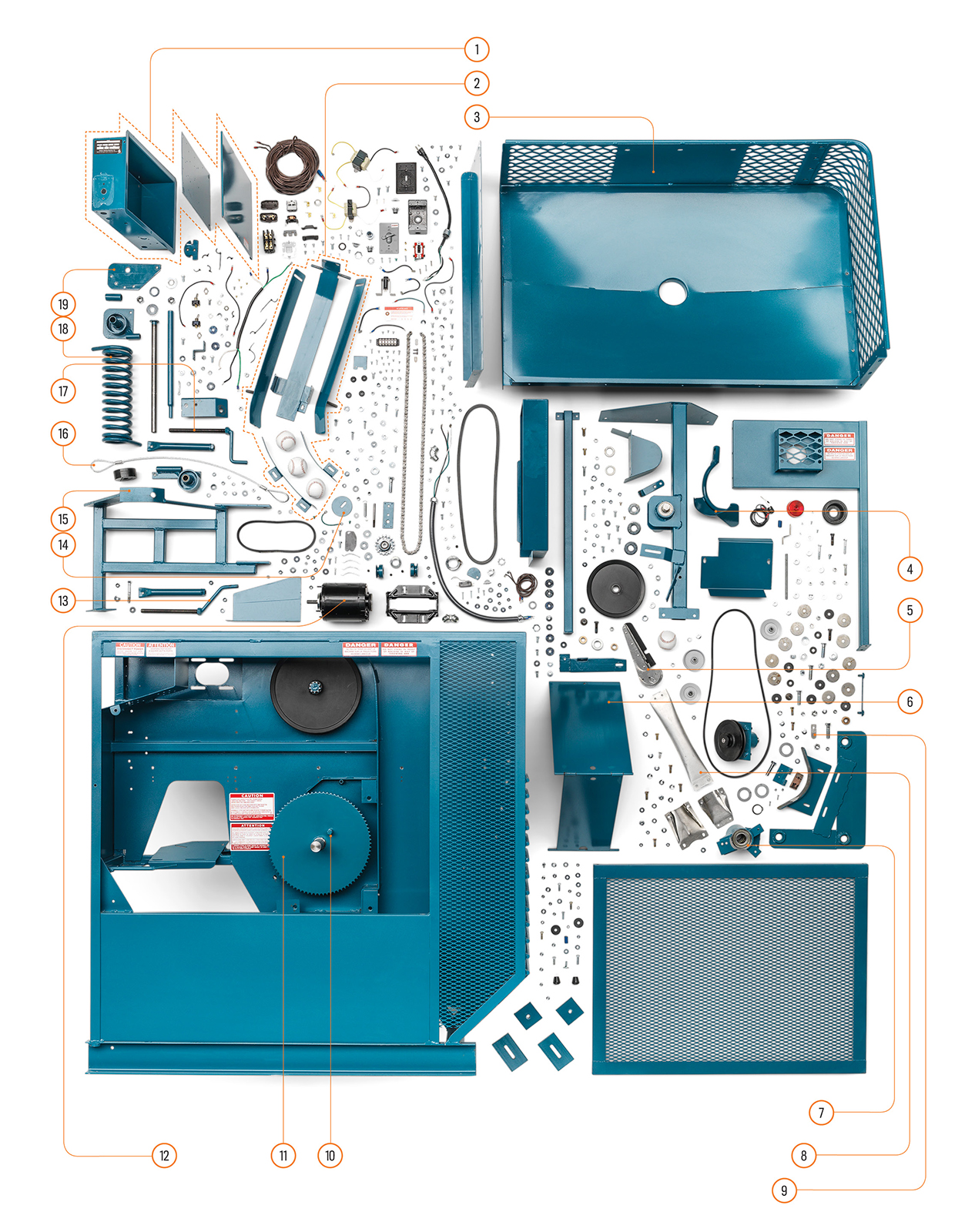Disassembly Report:
PITCHING MACHINE
Master Pitching Machine uses the Autodesk engineering & design solutions and CAD support from D3 to create machines that approximates a human-like pitch.
MODEL: MASTER PITCHING MACHINE MP-6 644
PRODUCED: KANSAS CITY, MISSOURI
TIME TO DISASSEMBLE: 5 HOURS, 34 MINUTES

NOTES: In the early 1950s, Paul Giovagnoli owned two driving ranges in eastern Kansas, and thought batting cages might be a good addition. When he had trouble tracking down the company that made them, Giovagnoli decided to build his own. In his apartment. The homegrown construction project got him evicted, but it was the beginning of Master Pitching Machine, which became the company his children run today. While other machines use spinning wheels to shoot balls through the strike zone, the arm action of Master Pitching's "Iron Mike" pitching machines approximates a human pitching motion, which makes for better batting practice.
Committed to innovation, the company powers its product development process with Autodesk Inventor software and validates its designs through finite element analysis (FEA) using Autodesk Simulation Mechanical. These sophisticated tools enable Master Pitching Machine to perform complex simulations to assess the performance of its machines before manufacturing. Master Pitching Machine looks to D3 Technologies for any support they need to get the most from their Autodesk software.
“D3 has always provided excellent support and partnership, and we look forward to working with them in the future as we continue to innovate,” notes Jim Giovagnoli, President of Master Pitching Machine.
PITCHING MECHANICS: Like a human pitcher, the Iron Mike has a shoulder, arm, hand, and finger. Unlike a human pitcher, it gets its energy from a 1/3-Hp AC motor (12) and a heavy-duty torsion spring 48). The motor connects to the shoulder—technically called the pitching-arm hub (7)—via a series of belts, pulleys, sprockets, and a drive chain. As the main sprocket (11) turns, its sprocket drive bushing (10) pushes on the shoulder. This rotates the arm (8) and pulls on the power cable (16), a wire rope that connects the shoulder to the spring. The spring coils tighter and tighter with the continued rotation of the sprocket until the arm snaps forward, like a mouse-trap springing shut.
LOADING: The MP-6 comes with a hopper (3) that holds 600 baseballs. Balls drop into the ball track (2) through a hole in the bottom. An adjustable agitator (4) spins around the hole to maintain a steady flow. The ball track funnels the balls down to the hand, where a ball stop (14) ensures that only one loads at a time.
THROWING STRIKES: Getting the ball through the strike zone is mainly about holding it properly. The angle between the hand (5) and the arm is the biggest factor in determining the height of the pitch. Cup the machine's hand in toward the arm and the pitch comes in lower. Pull it back and the pitch comes in higher. If the finger (9) isn't positioned properly, the ball will wobble as it is lifted and pitches won't be consistent. The ball travels a long way to get to home plate, so a hand adjustment as small as inch can change the height of the pitch by 4 feet. A crank of the height-adjusting handle (13) raises or lowers the spring-broom unit (15), which alters the release point of the pitch.
OFF-SPEED PITCHES: The Iron Mike's pitches top out at around 85 mph but can go as low as 30, depend-ing on the amount of tension on the spring. Connecting the power cable to the shoulder's nearer or farther hole puts the machine in high-speed mode or low-speed mode, respec-tively, by adjusting tautness.
The spring-tension plate (19) bolts the spring to the body of the machine. Its four different holes modify the spring's position so it has more tension before the power cable even begins to pull. Once those adjustments are made, the speed-adjusting handle (17) slightly coils or uncoils the spring for fine tuning.
AVOIDING BEAN BALLS: To prevent surprise pitches when the machine is powered up, the control-box (1) circuitry turns the machine off only after the arm has reached a position with low tension on the spring. If you're really concerned, you can also add a locking safety cover (6) that blocks the opening where pitches leave the machine. —KEVIN DUPZYK
This story appears in the October 2015 issue of Popular Mechanics. Photography credit goes to Todd McLellan
If your company would like to participate in a D3 Customer Spotlight, or if you would like to learn more, please contact D3.